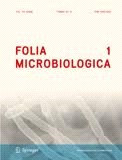Melter O, Radojevič B. Folia Microbiol (Praha). 2010 Nov;55(6):548–58. Epub 2011 Jan 21. IF: 0.978

Abstract:
Bacterial variants of Staphylococcus aureus called small colony variants (SCVs) originate by mutations in metabolic genes, resulting in emergence of auxotrophic bacterial subpopulations. These variants are not particularly virulent but are able to persist viable inside host cells. SCVs show their characteristic auxotrophic growth deficiency and depressed α-cytotoxin activity. Environmental pressure such as antibiotics, select for isogenic SCV cells that are frequently found coexisting with their parent wild-type strains in a mixed bacterial culture. SCV strains often grow on blood agar as non-pigmented or pinpoint pigmented colonies and their key biochemical tests are often non-reactive. Their altered metabolism or auxotrophism can result in long generation time and thus SCV phenotype, more often than not SCV can be overgrown by their wild-type counterparts and other competitive respiratory flora. This could affect laboratory detection. Thus, molecular methods, such as 16S rRNA partial sequencing or amplification of species-specific DNA targets (e.g. coagulase, nuclease) directly from clinical material or isolated bacterial colonies, become the method of choice. Patients at risk of infection by S. aureus SCVs include cystic fibrosis patients (CF), patients with skin and foreign-body related infections and osteomyelitis, as they suffer from chronic staphylococcal infections and are subject to long-term antibiotic therapy. Molecular evidence of SCV development has not been found except for some random mutations of the thymidylate synthase gene (thyA) described in SCV S. aureus strains of CF patients. These variants are able to bypass the antibiotic effect of folic acid antagonists such as sulfonamides and trimethoprim. Resistance to gentamicin and aminoglycosides in the hemin or menadione auxotrophic SCVs was hypothesized as being due to decreased influx of the drugs into cells as a result of decreased ATP production and decreased electrochemical gradient on cell membranes.
-mk-